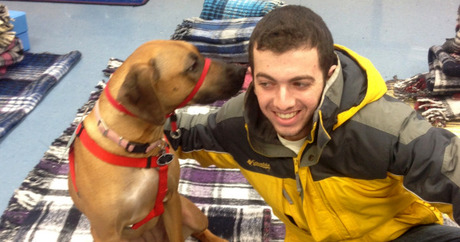Originally published Feb 8, 2017

Below is an excerpt from an article by Jaymi Heimbuch on Mother Nature Network. In it Ms. Heimbuch discusses how the sensitivity of canine noses is being used to screen human patients for a variety of medical problems including cancer, hypoglycemia, narcolepsy, seizure, and others. Today we want to focus on the part that discusses how service dogs are used in preventing P.T.S.D. attacks by sensing building fear and stress levels.
Fear and Stress
The age-old notion that dogs can smell fear is an accurate one. Dogs can smell when we are feeling fear or are experiencing an increased level of stress, even if we aren’t showing outward signs. What dogs are smelling is the surge of hormones our bodies release to respond to stressful situations, including adrenaline and cortisol.
Thankfully, this can be used to humans’ benefit, as dogs can signal a handler that they (or someone else) needs to take a few deep breaths. Dogs that alert handlers of the change in their emotional state — a change that often people aren’t even aware they’re experiencing — can help prevent panic attacks and other possible episodes associated with post-traumatic stress disorder or other issues.

Cali is one such dog. DogTime writes:
“This 18-month Rhodesian ridgeback is the first cortisol-sniffing dog on staff at a school. Cortisol is known as the ‘stress hormone,’ and people on the autism spectrum tend to have higher levels of cortisol in their blood. Cali is employed to detect rising cortisol levels in the students. She waits outside of school each morning as the students file by. If she notices anyone with a high level of cortisol in their blood, she will signal to her handler, Casey Butler, a health teacher on staff at The Calais School who is a certified specialist in natural canine behavior rehabilitation and in animal adaptive therapy. When Cali stares at a child, Butler knows that is the signal. She then takes that child aside and works with him or her before a meltdown occurs.”
We still have a long way to go to discover exactly what dogs are smelling about us, let alone how we can train them to be as accurate as possible about a change in our bodies. Even though many details are not yet known, it’s clear that dogs have an uncanny ability to sniff out certain medical issues, and that’s a skill that could be a real lifesaver.

Aside from being an interesting topic all on it’s own, this is of particular interest to Doug and I because Doug has started a new book that uses this topic as a major plot motivator. The book is fiction, but the main character is me: Cochise! I am so thrilled! In his book I am the service dog for a young man who has returned from war in the Middle East and suffers from P.T.S.D. His disorder is not the focus of the book, just one aspect of his character, but it plays an important part because the close relationship between him and his dog (me) is what the book is all about. His problem splits up his marriage and sets the two of us on the streets as we travel around solving mysteries and helping people. The working title at the moment is The Vagabond’s Dog.
And, not only am I the main character, but I get to narrate the story. Doug says the main challenge (which he says may prove insurmountable) is to tell this story through my eyes and my mind, without making it sound like I’m just a four-legged person. Dogs are different from people in many ways. Those differences have to be protected while telling the tale, yet average readers need to be able to understand the story and why things happen as they do. The book will explore human nature, dog training, dealing with P.T.S.D., and (hopefully) be entertaining as well. Don’t look for it any time soon, though: this is a major undertaking. But I’ll help him along as much as I can, after all, I am a kind of service dog too!
More on P.T.S.D. Dogs
- V.A. Will Not Cover Costs of P.T.S.D. Service Dogs.
- Dogs and PTSD – PTSD: National Center for PTSD
- Paws For Veterans – Ptsd Service Dogs, Psychiatric Service
- Registering Service Dogs – Register & List Your Service Dog.
| If you enjoy our updates, Doggy Tales, and educational articles consider subscribing for notices when new pieces are posted. It’s painless and you can unsubscribe any time you want. Your e-mail address is used ONLY to deliver these notices. | [email-subscribers namefield=”YES” desc=”” group=”Public”] |



